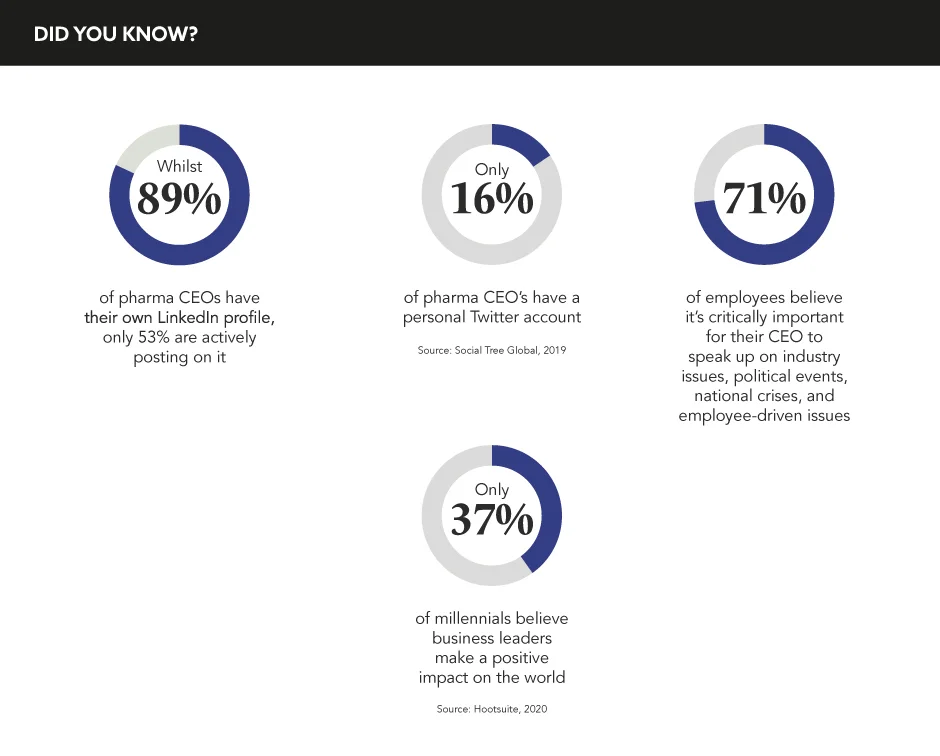Pharmaceutical companies have embraced the corporate social media account, but many lack the personal touch of a profile run by their leader. The opportunity to connect with employees and patients alike is unbounded; the time to log on is now
Words by Isabel O’Brien
A good leader wears many hats: they must be strategists, decision-makers, and communicators, with the ability to seamlessly interchange modes in a blink. For a long time, these hats have swapped and switched with equal regularity, but now, due to the explosion of social media, there is a greater demand for communication to remain in place.
The Ancient Greek playwright Euripedes once said, “It’s a clever man who can condense down many words into a brief space. And do it well.” In spite of his conspicuous sexism, Euripedes unknowingly described the purpose of social media: to communicate larger ideas in easily-digestible chunks.
Often though, the pharmaceutical industry views social media as something more complicated, like a virtual amphitheatre of the modern day: a place of unleashed opinions. The mingling of allies and enemies, friction, and community; all congealing together in a real-time stream of consciousness. Whilst this is in many ways accurate, it does not mean that industry leaders can cite compliance and remain spectators. Rather, they must exude the gladiator spirit and charge in, with a clear plan and objective in mind.
“Good social media comes from three tiers: strategy, training, and technology,” says James Saward-Anderson, Co-Founder, Social Tree Global. “You need to have a plan and clearly-defined measures of what success is. You need to train your leader to use social media, then use technology to ringfence human error (which always exists): providing intelligence and enhancing content.”
Given this triple tick box system, Saward-Anderson recommends that a first foray should be taken within the familiarity of LinkedIn: “LinkedIn is a great platform on which to start. This is because LinkedIn has fewer trolls, a high net worth per user database, and a business focus.”
Whilst protected from the full roast of mainstream social media, making a launch onto LinkedIn will still open a healthy floodgate of perspective and opinion from those within your organisation. “From an internal perspective, it has allowed me to keep in contact with employees: creating an open dialogue between us where I can get instant feedback,” says Susanne Schaffert, PhD, President Novartis Oncology.
What better way for industry leaders to connect with the people they serve than by building community through social media?
This will be a new experience but it positions the leader as open and engaged with their workforce, which can benefit everything from company morale to recruitment: “Glassdoor has an equal weighting on company culture and its approval of the CEO. The damage of hiding away from social is fast-becoming greater than the risk associated with being on it,” says Saward-Anderson.
In order to exert impact beyond the business world, leaders must stride from the safety of this network, to leverage the platforms favoured by patients and their families, who are already engaging in conversations about the industry.
Research by Worldcom Healthcare has shown that 58% of online conversations about pharma are taking place on Twitter, with the sentiment of the language used pegged at 87% neutral, 11% negative, and only 2% positive. “It’s no secret that pharma has experienced its fair share of reputational challenges. The only way we can overcome these challenges is by being transparent and talking more openly about what we do,” says Kris Sterkens, Company Group Chairman (EMEA) and Managing Director, Janssen. If more pharma leaders found their voice on these platforms, there would be an opportunity to disrupt this balance in the long term.
Beyond speaking transparently about company affairs, leaders like Sterkens and Schaffert use their channels to celebrate breakthroughs, share personal passions, and raise awareness of disease areas in which their companies are involved. “What better way for industry leaders to connect with the people they serve than by building community through social media?” says Patty Ryan, Vice President, Paid Social Media, Publicis Health Media.
“The journey of drug discovery, to the point where it reaches the patient, is long,” says Schaffert. “As a pharma leader, I can bring hope to others through sharing breakthroughs and progress on innovations on social media.”
“Becoming active on social media has been a great experience for me personally,” echoes Sterkens. “It’s brilliant to be able to discuss so many different topics in real time, and gain a deeper understanding of the initiatives and challenges we should be prioritising.”
Whilst hesitation is understandable, there is a myriad of untapped opportunities for leaders not yet on social media, with a stream of potential benefits available for both company reputation and for the global community of patients. It does not have to be a bloodied battle; rather it is as a new arena to conquer. All that is needed is a clear message and intention, plus a genuine urge to throw your hat into the ring.










